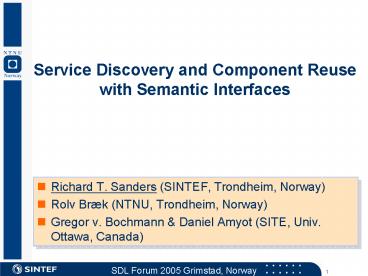Service Discovery and Component Reuse with Semantic Interfaces - PowerPoint PPT Presentation
Title:
Service Discovery and Component Reuse with Semantic Interfaces
Description:
2. Telecom and Informatics. SDL Forum 2005 Grimstad, ... a role is the part an actor (agent) plays in a service. a role describes a ... for Mobile Services (SIMS) ... – PowerPoint PPT presentation
Number of Views:47
Avg rating:3.0/5.0
Title: Service Discovery and Component Reuse with Semantic Interfaces
1
Service Discovery and Component Reuse with
Semantic Interfaces
- Richard T. Sanders (SINTEF, Trondheim, Norway)
- Rolv Bræk (NTNU, Trondheim, Norway)
- Gregor v. Bochmann Daniel Amyot (SITE, Univ.
Ottawa, Canada)
2
Conclusion
- Service components with semantic interfaces can
be described using UML 2.0 collaborations - interface role behaviour including goal
expressions - Liveness properties can be evaluated
- improvement over static interfaces
- Helps reuse, service discovery and role learning
3
Service oriented architecture
- a service is a collaboration between roles
- a role is the part an actor (agent) plays in a
service - a role describes a property of an actor
- actors may be involved in several services
Service component
4
Role modelling principles
call A-B
Actor
Actor
CA
CB
user A
user B
Semantic interface
Service component
UML 2.0 Collaboration
- Validate interfaces behaviour rather than
components - Safety properties
- Liveness properties
5
Service feature and a pair of semantic interfaces
modelled in UML 2.0
UserCall
Collaboration goal
Service feature
def goal Boolean A.VoiceCntTo(B) and
B.VoiceCntTo(A)
Semantic interface
Semantic interface
6
Interactions
Collaboration goal
7
Phases of a UserCall
UserCall
Invite
Collaboration goal
Calling goal VoiceCnt(A,B)
Busy
8
Semantic interfaces with goals and role behaviour
Role goal
- Role behaviour is a projection, and not a
complete behaviour (hence spontaneous output) - UML 2.0 does not adequately describe interface
behaviour (protocol state machines not
satisfactory)
9
Interface behaviour as transition charts
Role goal
- Caller and Callee are dual roles
10
Adding WaitOnBusy feature
- CallerW and CalleeW are dual roles
11
Safety requirements and subtyping
Removed ouput reduction
Added input extension
12
Subtyping relationships
UserCall
Caller
Callee
extension
reduction
UserCallW
CallerW
CalleeW
13
Using Semantic Interfaces
Y UserAgent
X UserAgent
Callee
Caller
Compatible UserCall.goal
yi
xi
Incompatible
Compatible UserCall.goal
W UserAgent
Z UserAgent
CalleeW
CallerW
Compatible UserCallW.goal
wi
zi
- Compatibility can be decided at design time
- Can be performed for types, not just instances
14
Role negotiation pattern
Run-time role validation
X UserAgent
Y UserAgent
Caller
Callee
B
A
15
Service role learning pattern
Result(idCallerW, provider)
X UserAgent
W UserAgent
Caller
CalleeW
BW
A
16
Work done
- Role projection and validation
- Role projection and safety validation algorithms
designed and implemented - Jacqueline Floch Compositional approach to
service validation (Thursday) - Progress validation algorithms design and
implemented - To be integrated in the tools used at Teleservice
Lab at NTNU
17
Work to be done
- UML tool support for UML 2.0 collaborations
- Compatibility checking of role binding at design
time - Composition of role behaviour from semantic
interfaces - Humberto Castejón Behaviour synthesis from
UML/UCM (Thursday) - Middleware support for service discovery and
selection - Role validation / negotiation at run-time
- Define ontologies for semantic interfaces
- Application to industry cases
- EU IST project 2006-2008
- Semantic Interfaces for Mobile Services (SIMS)
- SINTEF, NTNU, WUT, Appear Networks, Gentleware,
Amena,
18
Conclusion
- Service components with semantic interfaces can
be described using UML 2.0 collaborations - interface role behaviour including goal
expressions - Liveness properties can be evaluated
- improvement over static interfaces
- Helps reuse, service discovery and role learning
19
- Thanks for listening!































